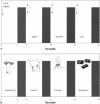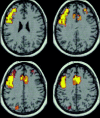Functional magnetic resonance imaging of verbal fluency and confrontation naming using compressed image acquisition to permit overt responses
- PMID: 12953304
- PMCID: PMC6872028
- DOI: 10.1002/hbm.10126
Functional magnetic resonance imaging of verbal fluency and confrontation naming using compressed image acquisition to permit overt responses
Abstract
Verbal fluency and confrontation naming, two tests of word retrieval, are of great utility in the field of cognitive neuroscience. However, in the context of functional magnetic resonance imaging (fMRI), movement artefact has necessitated the use of covert paradigms, which has limited clinical application. We developed two overt fMRI paradigms that allowed for performance measurement and hence were appropriate for use with patient groups. The paradigms incorporated a blocked-design and compressed-acquisition methodology where cues were presented and responses made in a "silent" period allowing for performance measurement. The slow response pace was specifically designed for older and potentially cognitively impaired participants. Verbal fluency was associated with activation in the middle frontal gyrus (Brodmann areas 46 and 9), anterior cingulate gyrus and inferior frontal gyrus (area 44 and 45). Confrontation naming activated areas of the temporo-occipital cortices (areas 18, 19, and 37) and the inferior frontal gyrus. The two paradigms successfully activated regions involved in executive and word retrieval processes and overcame the potential artefacts resulting from overt speech during image acquisition, providing useful neuropsychological tools to investigate cognitive deficits in clinical populations.
Copyright 2003 Wiley-Liss, Inc.
Figures



References
-
- Abrahams S, Goldstein LH, Kew JJ, Brooks DJ, Lloyd CM, Frith CD, Leigh PN (1996): Frontal lobe dysfunction in amyotrophic lateral sclerosis. A PET study. Brain 119: 2105–2120. - PubMed
-
- Abrahams S, Leigh PN, Harvey A, Vythelingum GN, Grise D, Goldstein LH (2000): Verbal fluency and executive dysfunction in amyotrophic lateral sclerosis (ALS). Neuropsychologia 38: 734–747. - PubMed
-
- Amaro E Jr, William SC, Shergill SS, Fu CHY, MacSweeney M, Picchoini MM, Brammer MJ, McGuire PK (2002): Acoustic noise and functional magnetic resonance imaging current strategies and future prospects. J Magn Reson 16: 497–510. - PubMed
-
- Baddeley AD (1986): Working memory. London: Oxford University Press.
-
- Baddeley AD (1996): Exploring the central executive. Q J Exp Psychol 49A: 5–28.
Publication types
MeSH terms
Grants and funding
LinkOut - more resources
Full Text Sources
Medical

